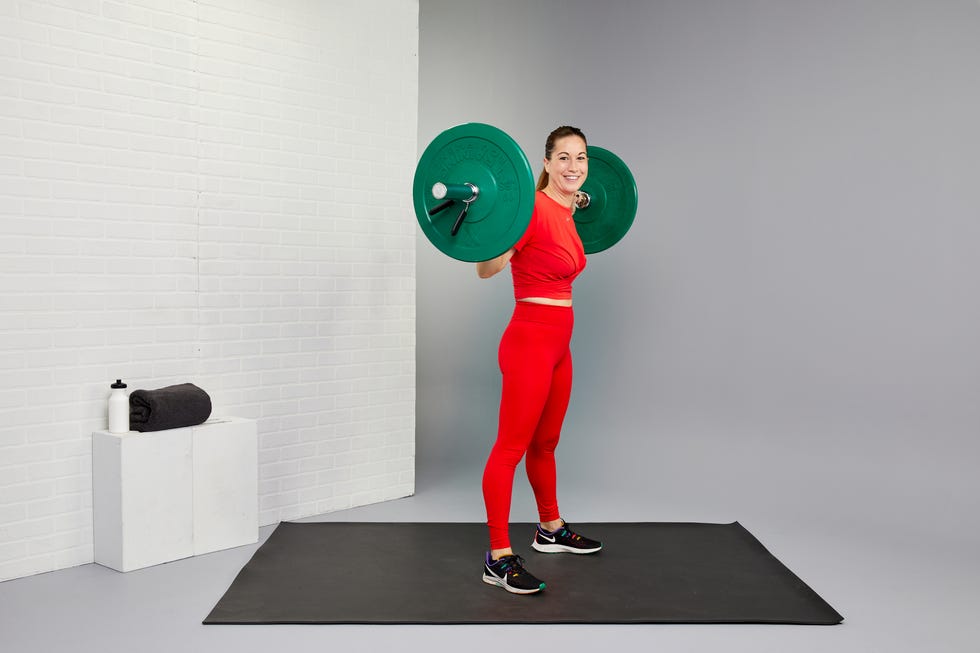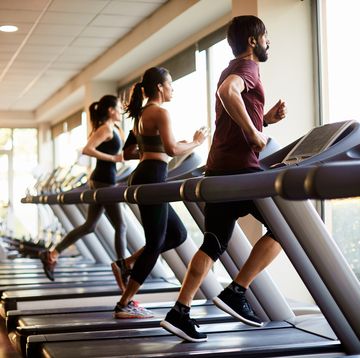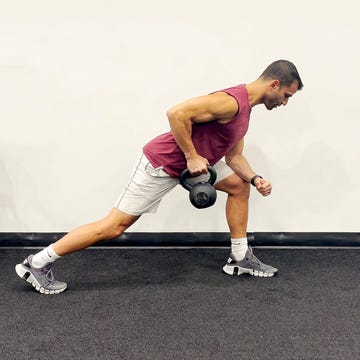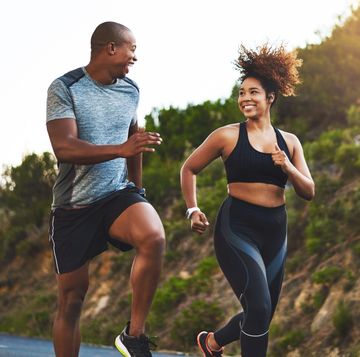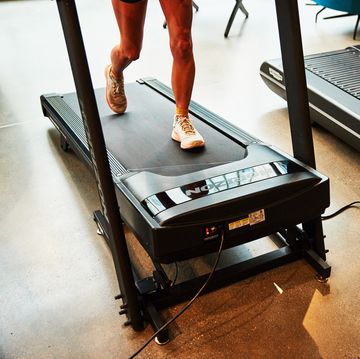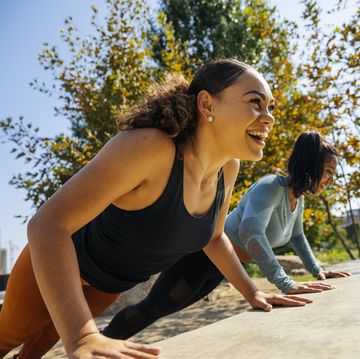To get better, runner’s need to run. That we know. But they also need to incorporate strength training into their routines if they really want to make strides. The stronger your muscles, “the more efficient at handling the loads placed on them during running,” says Alex Rothstein, C.S.C.S., coordinator and instructor for the exercise science program at New York Institute of Technology. The result: improved running economy and performance.
Shoring up your strength can also cut down your risk of injury by improving resiliency in your muscles, bones and tendons, says Natalie Niemczyk, D.P.T., C.S.C.S., a physical therapist, certified strength and conditioning specialist, certified run coach, and founder of Revolution Running in New York, noting that most running injuries involve these soft tissue structures.
Research backs up the benefits of strength training for runners. A study in the International Journal of Sports Physiology and Performance revealed that runners who combined heavy weight training (think Romanian deadlifts, parallel squats, calf raises, and lunges) with their running over a six-week period, had 5K times that were almost 4% faster than their counterparts who only pounded the pavement. Another one, a meta-analysis published in Sports Medicine, revealed that middle- and long-distance runners experienced improved performance with the addition of two to three heavy strength training sessions per week.
While you can make a case for any type of strength training, opting for barbell-based moves allows you to place a large external load onto your body in a safe and effective way, as well as progressively load a number of large compound movements like squats or deadlifts.
“You can go from 45 pounds—lighter if you have a different type of bar—to 1000 pounds in relatively small increments,” says Rothstein. “To have that kind of flexibility in training load you would need hundreds of differently weighted dumbbells or kettlebells.”
That doesn’t mean you have to go full-on body-builder. For runners, the goal is strength building versus muscle building, along with “performing the most efficient exercises and the most compound movements to reap the benefits of strength training without creating adverse fatigue in the process,” says Niemczyk.
This means your barbell workout should center around the large muscle groups. For the upper body, horizontal pushing, vertical pushing, and horizontal pulling moves (think bench press, overhead press, and bent over row, respectively) are key as “these exercises in small amounts will help to ensure the participant maintains a balanced upper body,” explains Rothstein. For the lower body, he says that exercises such as the squat, standard deadlift, and the split squat (like a stationary lunge) or Bulgarian split squat (with back foot elevated) will “help elicit adaptation focused on building strength in the running muscles.”
Join Runner's World+ for unlimited access to the best training tips for runners
Don’t worry about those new gains negatively impacting your running. “The amount of weight gained from weight training as a runner is insignificant to the amount of efficiency an individual gains from the additional muscle,” says Rothstein.
Thinking about stepping up to the barbell? Consider your current strength level first. Ask yourself a few basic questions to assess: Have you mastered foundational moves using just your body weight? Have you already been routinely strength training? Do you feel confident moving up to heavier weights? If the answer is yes, read on for some basic barbell workout tips.
What do I need to know about form when doing a barbell workout?
As with any type of exercise, good form is paramount. “Barbell training done with proper form can be one of the safest training modalities available—but with poor form can be one of the most dangerous,” says Rothstein.
Niemczyk reminds us that having a stable body position and the ability to use good body alignment when using the bar—this includes hand position, bar placement, and feet stance—is key to successful lifting.
Gifts for Runners mobility. Without it, you aren’t able to get into a good position to not only execute your moves but to actually engage all the necessary muscles. For example you have to have “enough dorsiflexion of the ankles in squats and lunges to reduce compensation of the trunk,” explains Niemczyk. You also have to have enough external rotation of the shoulders to use the barbell properly when placing it on the back of the body for moves like barbell back squats or rear-loaded lunges.
Finally, you can’t forget to breathe (sounds obvious, but not everyone pays attention to it). Believe it or not, this can help you lift even heavier. “Breathe in during the less stressful part of the exercise and breath out during the more stressful part of the exercise,” says Niemczyk.
“Remember that the form you have at the beginning of the set is just as important as the form you have at the end of the set, and this includes any initial lift-off you might have, such as during a bench press, squat, or bent-over row,” says Rothstein. Picking up the weight, moving it through the exercise, and then putting it back down all require good form—so maintain that good posture from start to finish.
How can I stay safe while I lift a heavy barbell?
You want your strength training to Adidas Supernova Rise, not bench you because you didn’t play it safe. Sure, you may know to keep your lifting area clear of stray weight plates, so you don’t trip over any equipment, but there are other guidelines that are crucial. To help shield you from injury, our experts offer these quick tips:
Choose your bar wisely. The traditional barbell found in gyms is the Olympic barbell, weighing in at 45 pounds. There is also the women’s Olympic bar, which weighs 35 pounds and is shorter. You may want to consider performing the moves with just the bar initially before scaling up with weight plates. But if you’re loading the bar, Niemczyk suggests alternating sides when placing the plates on. And don’t forget to secure your weight plates in place with a barbell collar so they don’t slip off mid lift.
Place it correctly. That bump or ridge in the back of your neck is the back of one of the bones of your spine. “You want to avoid placing pressure in that area,” says Niemczyk, noting that you should place your shoulders underneath the bar and make sure you get lined up properly for rear-loaded movements (or when the bar is behind the head and resting on the shoulders). She also says that you want your neck to be able to move freely. “It should not be restricted or pushed forward due to the bar placement.”
leaving you so sore. Buddies at the gym aren’t just good for pushing you to perform better, they also make great spotters. According to Niemczyk, it’s imperative to have one behind you while you begin to lift a heavier load for safety concerns and especially when you’re trying a new weight for the first time. No partner? Using the safety arms on the barbell rack can help to Minute Indoor Workout, says Rothstein, as they catch the bar (depending on the lift) if you fail a rep.
Know heavier is not always better. There’s always this idea that you should go big or go home. But when it comes to slinging around heavy weights, Rothstein says you should never compromise your form for more weight or even more reps. “The risk is not worth the reward,” he says.
The Best Barbell Workout for Runners
Ready to lift? Below are seven barbell exercises Niemczyk finds most beneficial for runners. These movements can help boost anyone’s running, but Niemczyk says that working with a coach to develop a strength plan tailored to your individual needs, taking into account your strengths and weaknesses, running journey, performance goals, running style, and injury history is always a smart move. She also recommends getting clearance from your doctor before beginning any strength training program.
Keep in mind, when doing heavy strength workouts like you do with a barbell, you don’t want to be completed fatigued by the end. It should complement your running, rather than Best Running Backpacks that it keeps you from running, Niemczyk explains. Also, aim to get in at least one day of squats and one day of deadlifts per week and try to keep squats and lunges on different days.
Published: Nov 10, 2021: No, Lifting Wont Make You Bulky banded exercises, like side steps. Then, choose one of the supersets below to focus on for your strength section for the day. Start with 3 sets of 12 reps to build your base of muscular endurance for 4-6 weeks. Then, focus on muscular strength by going for 4 to 5 sets of 5 reps. You can add the calf raises to any workout, following your completed superset, going for the same number of reps and sets.
Each move is demonstrated by Niemczyk so you can master the proper form. You will need a barbell, a bench, and an exercise mat is optional.
Superset 1
Squat
Stand with feet slightly wider than hip-width apart, barbell placed on back with shoulders under the bar and hands holding it slightly wider than shoulder-width apart, palms facing out. Keep your toes facing forward or slightly turned out, eyes forward, and back flat. Send hips back as if sitting into a chair, bending knees and lowering butt toward floor. Keep heels and toes on the ground. Aim to bring thighs parallel to the ground so hips and knees are in a 90-degree position. Drive feet into ground to stand back up. Repeat.
Overhead Press
Stand with feet hip-width apart, holding the barbell down in front of you with both hands placed slightly wider than shoulder-width apart. Pull elbows up to raise the bar to chest level, then pull elbows down so palms face out. Keep feet planted and a slight bend in knees. Push the bar up over head while engaging core and glutes. Slowly lower the bar back down to chest height. Repeat.
Superset 2
Romanian Deadlift
Stand with feet hip-width apart, holding the barbell down in front of you with both hands, placed slightly wider than hip-width apart. Keep toes facing forward and bend knees slightly. Send butt straight back, allowing he bar to travel straightway in front of the legs and down toward the floor. Squeeze shoulder blades back and down and keep head in line with spine. Stop when you feel a moderate pulling sensation in the hamstrings. Then, drive feet into ground and stand back up. Repeat.
Chest Press
Lie faceup on a bench, holding a barbell over chest with both hands placed slightly wider than shoulder-width apart. Make sure the bar is held at nipple level. Push the bar straight up until elbows fully extend. Then, slowly lower the bar back down to chest. Repeat.
Superset 3
Lunge
Stand with feet hip-width apart, barbell placed on back with shoulders under the bar and hands holding it slightly wider than shoulder-width apart, palms facing out. Step one foot forward and plant it into the ground. Then bend both knees 90 degrees, lowering back knee toward the floor. Front knee should stay over front ankle and back knee underneath back hip. Keep back neutral and straight and shoulder blades back and down. Then push off front foot to stand back up. Repeat on the other side. Continue alternating.
Rows
Stand with feet hip-width apart, holding the barbell down in front of you with both hands, placed slightly wider than shoulder-width apart and palms facing you. Hinge from hips by sending butt straight back and keep back flat with knees slightly bent. Pull the bar up and back toward torso, while squeezing shoulder blades together. Slowly lower the bar back down until elbows fully extend. Repeat.
Calf Raise
Stand with feet hip-width apart, barbell placed on back with shoulders under the bar and hands holding it slightly wider than shoulder-width apart, palms facing out. Lift heels off the ground while keeping toes pushed into the floor. Keep knees and hips straight. Pause, then lower heels back down. Repeat.

